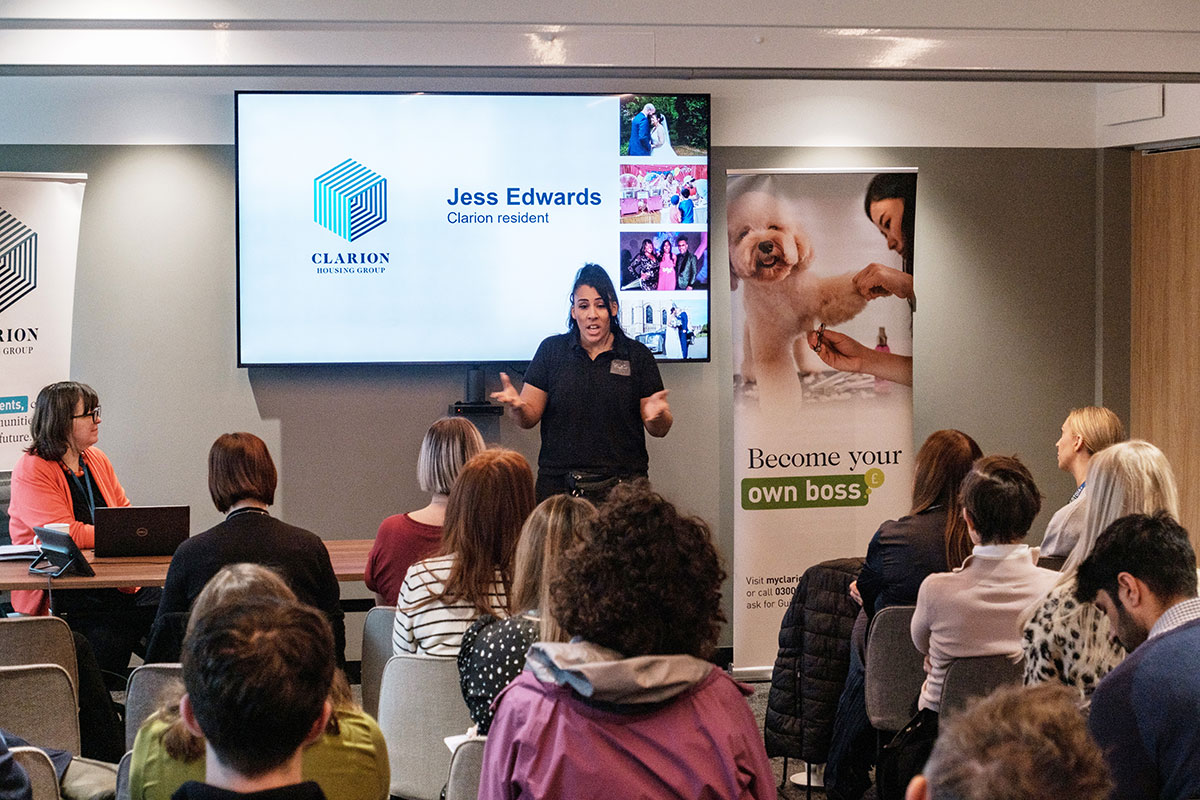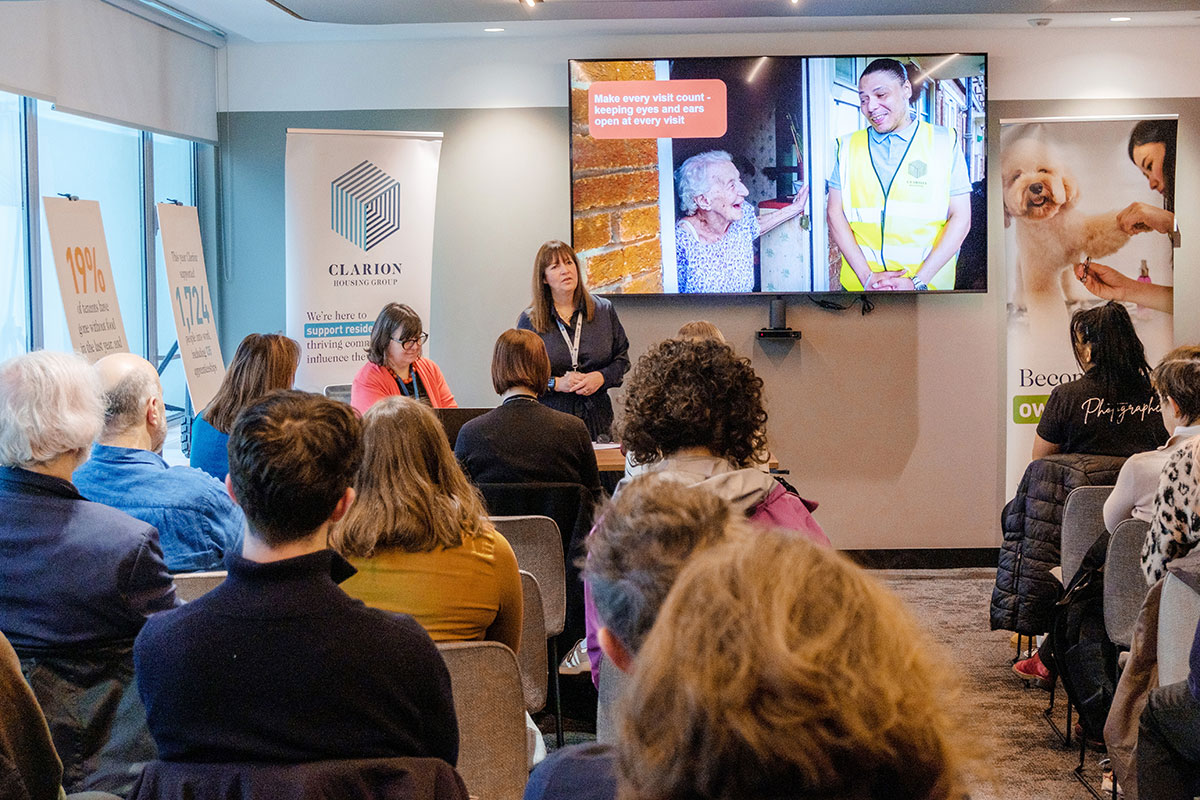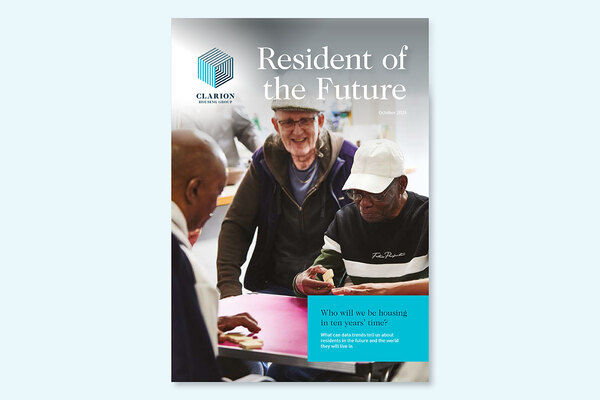The housing association tracking how the cost of living crisis is affecting residents
Clarion has surveyed its customers for the past 13 years. What has it found this year? And how is the housing association using this feedback to improve support for tenants? Katharine Swindells reports
Roughly six in 10 residents only have enough money to afford the essentials. That is one of the key findings from the 13th annual Clarion Index, the housing association’s bumper survey of 2,000 residents.
Inside Housing came to the launch of the index at Clarion’s head office in north London. We want to delve deeper into the survey findings, and speak to Clarion about how it is using these insights to inform strategy, and get support to those who need it most.
The survey, conducted in the summer and launched shortly before Christmas, found that 58% of residents run out of money at the end of the month, up from 49% in 2018. After a dip in 2020, due to the COVID support available, the number has continued to rise. And despite the supposed easing of the cost of living crisis, in the past year it went up by five percentage points.
“There’s been a significant increase in the need for advice and support around money guidance, so we’ve really used the insight to tailor the offers,” Michelle Reynolds, chief customer officer at Clarion, tells Inside Housing. She says this data has led the organisation to make changes such as providing more emergency finance support, enhancing digital access support, and making money advice easier to reach directly, rather than through the main contact centre.
The proportion of Clarion residents in receipt of Universal Credit has increased from 42% to 47% year on year. This includes 33% of residents who work, an increase from 29% last year.
However, there are signs that pressures may be plateauing, or even easing: last year, 74% of residents said they had reduced their heating and energy usage, and this year that decreased to 62%. And in 2023, 64% said they had reduced leisure and social activities, which this year fell to 55%.
There has also been a small year-on-year decrease in the proportion of residents going without food because they can’t afford it. The decline is clearest among 18 to 34-year-olds, now 19% compared to 29% last year.
Clarion Futures, the housing group’s charitable arm, is using the index findings to inform its employment support offering, its director Phil Miles explains.
Disabled tenants
The index includes crucial findings about disabled tenants. The proportion of respondents who say they have a disability has risen. And this isn’t only among older people – a third of 18 to 24-year-olds said they had a disability, up from 23% the year before.
Disabled residents are less likely to be satisfied with their neighbourhood, and less likely to say they feel they belong, compared to their non-disabled neighbours. Three in 10 disabled residents (29%) say they don’t feel safe in their neighbourhood, compared to 18% of those who are not disabled.
Among disabled residents, one in four indicated that their homes do not meet their accessibility needs (24%). This rises to 35% among those who live on the first floor of their building, and 41% among those who live on the third floor or higher.
Two-thirds of disabled residents are struggling with their finances and running out of money, and nearly half are finding it difficult to afford their energy bills, significantly higher than the average.
Six in 10 disabled residents say their mental health got worse during the pandemic, compared to an overall average of 48%.
So how will this inform Clarion’s work? Ms Reynolds says it is a “can opener”, and now Clarion needs to do more research to find out more about this customer group.
“So we’re going to go back to customers that have said they’ve got a disability and are willing to talk to us more
to understand what can we as a landlord or Futures do to improve access to services, how can we support, or do we need to advocate to statutory services?” she says.
This information will only become more important, Ms Reynolds says, so Clarion is undertaking a large piece of work around its ‘future customer’. Who will be the Clarion residents in 10 years’ time, and how can the organisation be prepared for them?
The survey results show this support is more needed than ever, with the proportions of residents who are unemployed and looking for work up annually across every age category – particularly among 18 to 24-year-olds, of whom the percentage rose from 27% to 35% in a year.
But perhaps more striking is the increasing number of people out of work due to disability or long-term health conditions, which is now at 18%, compared to 14% in 2019 (see box above: Disabled tenants).
“Over the years, we’ve built up quite an understanding and expertise in supporting people who are further away from the labour market and who need extra support to get back to work,” Mr Miles says.

This includes tailored 360-degree support for some residents through the Active Inclusion programme, which targets those facing multiple complex barriers to employment.
The findings from the Clarion Index, particularly the points around disability and long-term sickness, may suggest that this programme needs expanding.
A resident’s story
Jess Edwards (pictured above) lives with her three children on a Clarion estate in Mitcham, south London. She grew up on the estate in the 1990s. She was a young carer for her mother, who struggled with mental illness, and her siblings.
“Growing up, I was one of those people who you would have thought, ‘They don’t have a chance, they’re not going to make it,’” she says.
As an adult, with undiagnosed ADHD and no family support, Ms Edwards struggled to hold down a job. “I found it very hard to work for an employer. But before I had counselling, I never understood what was wrong with me. Why do I find it so hard? It really dragged me down.”
She wanted to start a photography business, taking family portraits for people on low incomes. “I wanted to be my own boss, but I doubted myself too much.”
Ms Edwards heard about Clarion Futures when she went to a healthy cookery workshop on the estate. “I actually know a lot about healthy eating, but I heard we’d get a free slow cooker,” she quips, and the room bursts out laughing. But there she met a member of staff who recommended Clarion Futures to her. The organisation provided training and mentoring, and now her business, Captured by Jess, is thriving.
“Understanding people like me who have past experiences like trauma, who have learning difficulties and disabilities, is important to understand where the support is needed,” she says. “These surveys help to reach people like me, and Clarion Futures has played a massive part in me becoming who I am.”
The afternoon before our conversation, Mr Miles met with the government minister for social security and the minister for employment to discuss the work Futures does.
“From the discussions with ministers yesterday, that’s exactly the kind of support they’re looking at to support the economically inactive into work,” Mr Miles says.
“It’s about relationships with health providers and other support agencies, creating a whole package together – that is quite a powerful support mechanism for people.”
But what is important, Mr Miles adds, is that this work comes from a place of active engagement. “Unlike, say, the job centre, they’re not mandated to come to a housing association to get support. We have to engage them, we have to gain their trust, and they have to want to work with us,” he says.
7%
Residents in work who say they always or often feel lonely
25%
Working-age residents not in work who say they always or often feel lonely
This work is important, not only for the financial security of residents and their tenancies, but also because, as the survey shows, it has a clear correlation with mental health and well-being.
Of working-age residents who are unemployed, 80% report a feeling of belonging, compared with 90% of those who are in work. A quarter of working-age residents who are not in work say they always or often feel lonely, compared to just 7% of those in work. Similarly, 24% of those with a disability say they feel lonely, compared to 8% without.
Clarion has a huge amount of support available both through its main services and its Clarion Futures arm – whether this is on repairs and tenancy issues, help with digital access, money and benefits advice, or employment support (see box above: A resident’s story.)
But the worry is that residents aren’t aware of these services. When asked which Clarion services they were aware of, 48% of respondents said they had not heard of any. There is still a lot of work to do to increase awareness. And there is a fear that the people who are left behind are the ones who need support the most.
Mr Miles says: “This is where ‘know your customer’ is really important. We’re working with the housing teams at the moment to identify those customers who aren’t necessarily contacting us – that small number who we don’t hear from. We have to find ways of reaching those who may need that support but aren’t asking for it.”
Recent longform articles by Katharine Swindells
Top 50 Biggest Builders 2024
Which are the 50 housing associations building the most homes? What tenures are they building? And, with warnings already sounded about starts by the G15, what is happening to the pipeline? Katharine Swindells reports
Ready to check out: the lengthy repairs forcing tenants to live in hotels
Inside Housing has found tenants waiting months in temporary accommodation for repairs on their homes to be completed – or even started. Katharine Swindells reports
The estate where tenants are taking collective legal action on damp and mould
Tenants on one east London estate are teaming up to file a joint legal claim about the damp and mould in their homes. Katharine Swindells reports
The case for flooring to be included when social homes are let
Wales has just passed regulations that new social lets must come with flooring included. But with hundreds of thousands of families across the UK still living in social homes without carpet and flooring, should English and Scottish social landlords follow suit? Katharine Swindells reports
Sign up for our daily newsletter
Already have an account? Click here to manage your newsletters












